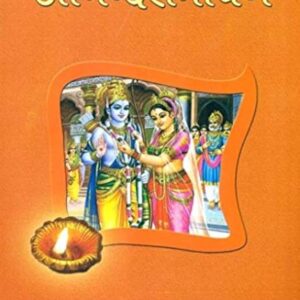Ramayan
The Ramayana is one of the two major Sanskrit epics of ancient Indian literature, the other being the Mahabharata. Composed by the sage Valmiki, the Ramayana is a revered text in Hindu tradition, detailing the life, adventures, and trials of Prince Rama, an incarnation of the god Vishnu. The epic is not only a profound literary work but also a spiritual and cultural touchstone for millions of Hindus worldwide.
Overview and Structure
Epic Nature:
- The Ramayana is an epic narrative that combines mythology, history, and moral teachings. It consists of approximately 24,000 verses and is divided into seven books (kandas), each focusing on different phases of Rama’s life.
Seven Kandas:
- Balakanda (Book of Youth):
- This book narrates the early life of Rama, including his birth in the city of Ayodhya, his education, and his marriage to Sita, the daughter of King Janaka.
- Ayodhyakanda (Book of Ayodhya):
- This section describes the events leading to Rama’s exile, including the intrigues of Kaikeyi, one of King Dasharatha’s queens, who demands that Rama be exiled to the forest for fourteen years so that her son Bharata can ascend the throne.
- Aranyakanda (Book of the Forest):
- During his exile in the forest, Rama, accompanied by his wife Sita and brother Lakshmana, encounters sages, demons, and various challenges. This section includes the abduction of Sita by the demon king Ravana.
- Kishkindhakanda (Book of Kishkindha):
- Rama forms an alliance with the monkey king Sugriva and his loyal companion Hanuman to search for Sita. This book details the adventures and battles that occur in the monkey kingdom of Kishkindha.
- Sundarakanda (Book of Beauty):
- Hanuman’s heroic journey to Lanka, his discovery of Sita in Ravana’s palace, and his burning of Lanka are the highlights of this book. It is celebrated for its poetic beauty and depiction of Hanuman’s devotion.
- Yuddhakanda (Book of War):
- The climactic battle between Rama’s forces and Ravana’s army takes place in this book. It ends with the defeat and death of Ravana, the rescue of Sita, and Rama’s return to Ayodhya.
- Uttarakanda (Book of the Aftermath):
- This concluding book describes Rama’s reign as king, the doubts cast on Sita’s purity, her subsequent exile, and the birth of her twin sons, Lava and Kusha. It ends with Sita’s return to the earth and Rama’s eventual departure from the world.
Central Characters
- Rama: The hero of the epic, Rama is the prince of Ayodhya and an avatar of Vishnu. He is the embodiment of dharma (righteousness) and ideal conduct.
- Sita: Rama’s devoted wife, who is the incarnation of the goddess Lakshmi. Sita’s purity, strength, and devotion are central themes of the Ramayana.
- Lakshmana: Rama’s loyal brother who accompanies him into exile and stands by him through all trials.
- Ravana: The ten-headed demon king of Lanka who abducts Sita, leading to the epic battle with Rama.
- Hanuman: The devoted monkey warrior and ardent follower of Rama, celebrated for his strength, loyalty, and devotion.
- Dasharatha: The king of Ayodhya and father of Rama, whose promise to his queen Kaikeyi sets the events of the Ramayana into motion.
Key Themes and Teachings
Dharma (Righteousness):
- The Ramayana explores the concept of dharma through the actions and choices of its characters. Rama’s adherence to dharma, even in the face of personal loss and hardship, is a central theme.
Devotion and Loyalty:
- The epic highlights the virtues of devotion and loyalty, particularly through the characters of Sita, Lakshmana, and Hanuman. Their unwavering support and faith in Rama exemplify these qualities.
Good vs. Evil:
- The struggle between good and evil is a recurring theme, embodied in the conflict between Rama and Ravana. The ultimate triumph of good over evil is a moral lesson that resonates throughout the epic.
Suffering and Exile:
- The experiences of exile, suffering, and eventual redemption faced by the characters underscore the transient nature of life and the importance of resilience and moral integrity.
Ideal Relationships:
- The Ramayana presents ideals of various relationships—between husband and wife (Rama and Sita), brothers (Rama and Lakshmana), and devotee and deity (Hanuman and Rama).
Influence and Legacy
Cultural and Religious Impact:
- The Ramayana has had a profound impact on Hindu culture, religion, and philosophy. It is recited and celebrated in festivals such as Diwali and Rama Navami, and its stories are depicted in art, dance, and theater across India and Southeast Asia.
Literary and Artistic Contributions:
- The Ramayana has inspired countless adaptations and retellings in various languages and formats, including poetry, prose, drama, and film. It has influenced the literature and performing arts of many cultures.
Moral and Ethical Guidance:
- The ethical and moral teachings of the Ramayana continue to provide guidance and inspiration to millions of people. The characters’ virtues and struggles offer timeless lessons on living a righteous and meaningful life.
Conclusion
The Ramayana is a timeless epic that transcends its historical and cultural origins to offer universal lessons on duty, devotion, and righteousness. Through its captivating narrative and profound teachings, the Ramayana continues to inspire and guide generations, reflecting the enduring wisdom of ancient Indian culture.
Showing all 8 results
Anand Ramayan : आनंद रामायण
RamayanKamba Ramayan : कम्ब रामायण:
RamayanManas Manthan : मानस मंथन
Ramayan








